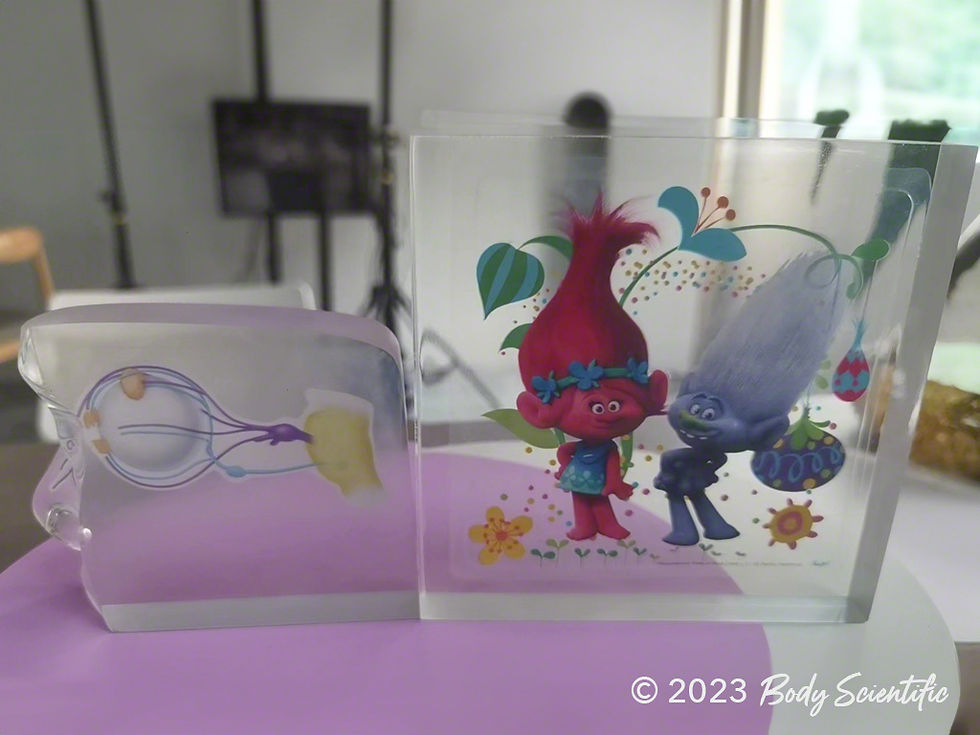Crafting Clarity in Tear Anatomy Education
- Marcelo Oliver
- Jan 9, 2024
- 3 min read

With the success of our clear head model with an embedded eye and structures associated with tear anatomy, the company came back asking for a less expensive version to leave behind in doctors' offices. The head models with carrying case were used and transported by the sales team and not left behind as a patient education model, given the investment required for such a premium educational tool. So we were tasked to figure out a more economical iteration of a similar anatomical piece that is just as eye-catching and effective at teaching the important anatomy of tear film production.

Charged with the task of devising an anatomical marvel that would not only capture attention but also prove economically viable, our first brainstorm led us to consider the radical idea of halving the head to feature a singular eye. This ingenious maneuver promised to slash production costs by half, an economic feat achieved through prudent material conservation—after all, halving the head equates to halving the resin consumption! However, in our relentless pursuit of budget-friendliness, it became apparent that a mere cranial bisection would not suffice as it was still heavy and bulky. We also considered a slice of the head as-is. A contemplative gaze from above revealed that a facial slice was the key to unlocking the comprehensive anatomy of tear film production. Yet, the challenge lay in recognizability; to keep the face recognizable we needed to use commonly viewed cross section such as a sagittal cut or to include the nose.

Exploring the possibility of how to fit the very space occupying anatomy into a 1-inch acrylic slice of the face with a recognizable nose. To include all of the eye anatomy to scale, the slice would be on an obscure angle that does not include the nose. The final facial slice includes a flat surface to view the anatomy inside, and also hints at the nose for both facial recognition. The nostril has an opening large enough to show how the nasal spray would fit within the nose.

We drew inspiration from existing products featuring 2D artwork printed on clear transparency. However, our creative ambition soared beyond the confines of conventional designs. The solution lay in imparting a three-dimensional illusion, elevating the artwork with a subtle yet impactful raised relief. This innovative touch not only enhanced the model's aesthetic appeal but did so without imposing a significant financial burden, as the anatomical foundation remained rooted in a 2D illustration.

Employing the technique of raised relief involves printing on plastic and then vacuum forming the illustration onto a mold, generating a compelling illusion of depth. Our skilled 3D modeler utilized Zbrush to meticulously craft the three-dimensional version of the mold, sculpting it akin to digital clay by strategically adding and subtracting pixels from the original illustration. This digitally sculpted mold is then exported and transformed into a tangible, physical counterpart.

After numerous versions, iterations, and samples, a working prototype emerged—a testament to our relentless pursuit of perfection. Yet, the journey was not without its challenges, as the unforgiving nature of working with a clear material demanded unparalleled precision. The manufacturing process became a delicate technique, requiring pristine environments, equipment, and hands to ensure the avoidance of specks and imperfections during the curing process.


The culmination of our efforts materialized in a resounding success, eagerly anticipated by our discerning client for their annual sales meeting. With the knowledge and experience gleaned from the intricate dance with the facial slice, we antipicate to craft more transparent masterpieces, pushing the boundaries of educational artistry.

Please connect with us if you have a specific model you would like to see created in the transparent anatomy marketplace, info@bodyscientific.com.
Comentarios